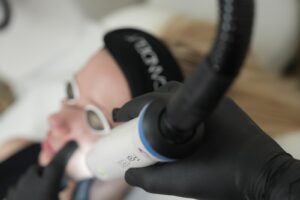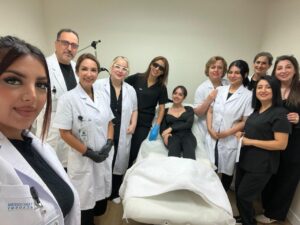OZEMPIC FACE AND FACIAL FAT LOSS
Faramarz Rafie M.D. / VANCODERM ACADEMY (VDA)/ VANCODERM CLINIC (VDCMED)
Ozempic (Semaglutide) is a once-weekly injectable prescription medication in the class of GLP-1 receptor agonists, primarily used to improve blood sugar control in adults with type 2 diabetes and, more recently, to aid in weight management for certain patients. It works by mimicking the hormone GLP-1 (glucagon-like peptide-1), which stimulates insulin release, reduces glucagon secretion, slows stomach emptying, and helps control appetite, leading to reduced food intake and potential weight loss.
Facial fat plays a crucial role in maintaining youthful volume, shape, and balance of the face. It is distributed in multiple fat pads — both superficial (just under the skin) and deep (beneath muscles) — that provide fullness to areas like the cheeks, temples, lips, and under the eyes. These fat pads act as natural cushions, supporting the skin and underlying structures, softening facial contours, and helping to reflect light evenly for a healthy, smooth appearance. Beyond aesthetics, facial fat also contributes to skin tension and elasticity by providing structural support. When facial fat is lost — whether through aging, rapid weight loss, or medications that promote weight reduction — the result can be sunken cheeks, hollow temples, more pronounced lines and folds, and sagging skin, all of which can make the face appear older or more tired.
Ozempic (Semaglutide) is injected into the belly, thigh, or upper arm, but its effects are systemic — meaning the medication works throughout the body, not just where it’s injected. It helps regulate blood sugar and suppress appetite, often leading to overall weight loss. Since fat loss happens body-wide, not just at the injection site, it can include the gradual reduction of facial fat pads. When these fat pads shrink, especially in the cheeks, jawline, and under-eye area, the face may appear slimmer or more hollow — a change often referred to as “Ozempic face.” This is a result of overall fat loss combined with skin’s natural tendency to sag slightly when underlying volume decreases, not a direct local effect of the injection itself.
Ozempic face” can appear at any age, but it tends to be more noticeable in people over 40. That’s because, as we age, the skin naturally loses collagen, elastin, and fat, and its ability to bounce back after weight loss decreases. In younger individuals, the skin is generally thicker, more elastic, and better able to retract, so facial volume loss may be less visible. In contrast, those in their 40s, 50s, and beyond are more likely to show hollowing in the cheeks, sagging along the jawline, and under-eye hollows after rapid weight loss — whether from Ozempic or any other cause.
The facial changes often called “Ozempic face” can also happen with Mounjaro (Tirzepatide) and other Semaglutide products, as well as with similar GLP-1 receptor agonists. The effect isn’t specific to the brand or the injection site; it’s a result of rapid, body-wide fat loss. These medications work systemically to reduce appetite, improve insulin sensitivity, and slow digestion, which can lead to significant weight loss. When facial fat pads shrink faster than the skin can adjust — especially in older adults — hollowing, sagging, and sharper facial contours may appear, regardless of whether the medication is Ozempic, Wegovy, Rybelsus, Mounjaro, or a similar drug.
“Ozempic face”
- Term used in media to describe facial fat loss and the resulting more hollow or gaunt look.
- The face naturally contains subcutaneous fat that maintains youthful volume. When weight loss occurs, especially quickly, this fat is reduced, leading to:
- Sunken cheeks or temples
- More prominent facial bones
- Increased appearance of fine lines and wrinkles
Skin laxity
With rapid weight loss, the skin may not have enough time to contract fully, resulting in loose or sagging areas, particularly along the jawline or beneath the eyes. This effect tends to be more noticeable on the face because facial skin is thinner and continually subjected to the pull of gravity.
 Changes in complexion
Changes in complexion
Some individuals experience a healthier glow from improved blood sugar control, while others notice a duller complexion if weight loss is paired with nutritional deficiencies. Rapid calorie reduction without sufficient protein intake can contribute to collagen loss, which in turn affects skin texture and overall appearance.
Psychological perception shift
Changes in facial proportions can alter how others perceive expressions — sometimes making a person look more tired or older, even though they’re healthier overall.
Mitigating these effects
Gradual weight loss is generally gentler on facial appearance, as it allows the skin more time to adapt. Maintaining adequate protein intake supports both muscle and collagen, while incorporating strength training helps preserve lean mass, including the facial support structures. For those seeking additional enhancement, non-surgical options such as dermal fillers, skin-tightening treatments, or collagen-stimulating procedures can help restore volume and firmness
Preventing facial volume loss—especially during weight loss or while using medications like Ozempic—focuses on slowing the rate of fat loss, preserving skin elasticity, and maintaining structural support. Key strategies include:
- Gradual Weight Loss
- Aim for slower, steady weight reduction (about 0.5–1 kg per week) to give skin and underlying tissues time to adapt.
Adequate Protein Intake
- Supports collagen production and muscle mass, which help keep facial contours firm.
- Include high-quality protein at each meal (lean meats, fish, dairy, legumes).
Strength & Resistance Training
Preserves lean muscle mass in the body and helps maintain the deeper structural support of the face.
Hydration & Skin Nutrition
- Drink enough water and include omega-3–rich foods to support skin barrier and elasticity.
- Ensure adequate vitamins C, E, and zinc for collagen synthesis.
Sun Protection
Daily SPF prevents UV-induced collagen breakdown that worsens sagging.
 Collagen-Boosting Skincare & Treatments
Collagen-Boosting Skincare & Treatments
Topical retinoids, peptides, and professional treatments like Non-Ablative Fractional Resurfacing Laser Frax:1550 nm Candela, Microneedling, Radiofrequency, or Ultrasound skin tightening can stimulate collagen and elastin.
Dermal Fillers or Fat Grafting (if needed)
Non-surgical or surgical options to restore lost volume once fat pads have diminished.
Collagen-Stimulating Treatments (Prevent & Delay Sagging)
These can be started during weight loss to encourage skin contraction and maintain firmness.
- Microneedling with Radiofrequency (RF) – Stimulates deep dermal collagen and elastin, tightens skin, and improves texture.
- High-Intensity Focused Ultrasound (HIFU) – Targets deeper layers (SMAS) to lift and tighten without downtime.
- Fractional Laser Resurfacing – Boosts collagen remodeling while improving skin tone.
- Biostimulatory Fillers – Not only fill but stimulate the body’s own collagen production over months.
 Volume Restoration Treatments (Correct Hollowing)
Volume Restoration Treatments (Correct Hollowing)
Best done after weight loss stabilizes, to avoid repeating corrections.
- Hyaluronic Acid (HA) Dermal Fillers – Restore midface fullness, temples, and under-eye hollows; results are immediate and natural-looking when done conservatively.
- Fat Grafting / Fat Transfer – Uses the patient’s own fat from another body area, offering a more permanent solution than fillers.
- Hybrid Approach – Combining HA fillers for precise shaping with biostimulatory fillers for long-term collagen support.
Skin Quality Enhancement (Maintain Glow & Firmness)
PRP or PRF (Platelet-Rich Plasma/Fibrin) – Improves skin texture and elasticity by delivering growth factors.
Mesotherapy / Skin Boosters – Infuse hyaluronic acid and vitamins for hydration and plumpness.
LED Light Therapy – Enhances cellular repair and reduces inflammation.
 Best Practice for Prevention
Best Practice for Prevention
For patients starting Ozempic, combining collagen-stimulating treatments during weight loss with volume restoration after weight stabilizes gives the most natural and lasting results. Early intervention is key—once sagging and hollowing are severe, correction becomes more invasive.
Thank you for visiting the Vancoderm Academy blog and sharing in our passion for advancing knowledge in medical aesthetics and wellness. We welcome you to be part of our vibrant community—stay connected, explore our expert-led training programs,
and join us in shaping the future of beauty and healthcare together.
References:
- https://www.icls.ca/blog/ozempic-side-effects-skin-face/
- https://health.clevelandclinic.org/ozempic-face
- https://www.drugs.com/medical-answers/ozempic-face-3572731/
- https://www.looknatural.com/blog/ozempic-facial-side-effects

